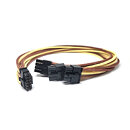T0@st
News Editor
- Joined
- Mar 7, 2023
- Messages
- 3,063 (3.88/day)
- Location
- South East, UK
| System Name | The TPU Typewriter |
|---|---|
| Processor | AMD Ryzen 5 5600 (non-X) |
| Motherboard | GIGABYTE B550M DS3H Micro ATX |
| Cooling | DeepCool AS500 |
| Memory | Kingston Fury Renegade RGB 32 GB (2 x 16 GB) DDR4-3600 CL16 |
| Video Card(s) | PowerColor Radeon RX 7800 XT 16 GB Hellhound OC |
| Storage | Samsung 980 Pro 1 TB M.2-2280 PCIe 4.0 X4 NVME SSD |
| Display(s) | Lenovo Legion Y27q-20 27" QHD IPS monitor |
| Case | GameMax Spark M-ATX (re-badged Jonsbo D30) |
| Audio Device(s) | FiiO K7 Desktop DAC/Amp + Philips Fidelio X3 headphones, or ARTTI T10 Planar IEMs |
| Power Supply | ADATA XPG CORE Reactor 650 W 80+ Gold ATX |
| Mouse | Roccat Kone Pro Air |
| Keyboard | Cooler Master MasterKeys Pro L |
| Software | Windows 10 64-bit Home Edition |
MODDIY has swiftly updated its Help Center site with new guidelines, following recent reports of one of its older 12VHPWR cable designs having a high temperature disagreement with an NVIDIA GeForce RTX 5090 Founders Edition card and ASUS ROG Loki SFX-L power supply unit. The company's newest batch of (2025) 12V-2X6 and 12VHPWR are manufactured with the latest specifications and standards in mind, thus given the all-clear for utilization with NVIDIA's recently introduced GeForce RTX 5090 and RTX 5080 graphics cards. Any products from the 2024 production cycle (and before) are deemed safe to use with the GeForce RTX 40-series, but not "officially" valid for anything newer.
The company's renewed guidelines state: "as of 2025, the industry standard has transitioned to 12V-2X6, replacing the previous 12VHPWR standard. Our new cables incorporate significant advancements, including enhanced terminal and connector housing materials, along with thicker wires, to provide an additional safety buffer for the latest GPUs. At MODDIY, all 12VHPWR / 12V-2X6 cables purchased from 2025 onward are manufactured in accordance with the new 12V-2X6 specifications and standards, ensuring compatibility and optimal performance with the RTX50 series GPUs. Prior to 2024, the RTX50 series GPUs had not yet been introduced, and the prevailing standard was 12VHPWR. All cables produced before this period were designed and tested for use with the RTX40 series GPUs. We recommend that all users upgrade to the new 12V-2X6 cables to take full advantage of the enhanced safety and performance features offered by this new standard." They believe that their messily-named "ATX 3.1 PCIe 5.1 H++ 12V-2X6 675 W 12VHPWR 16 Pin Power Cable" premium custom tailor-made model is the best candidate for Team Green's modern generation of gaming cards.




The Verge's Tom Warren weighed in on the matter; highlighting the need for greater transparency from key industry players: "MODDIY is now recommending that RTX 50 series owners upgrade to 12V-2X6 cables instead of using existing 12VHPWR cables. NVIDIA and PSU manufacturers need to urgently clarify the situation here, as Corsair and others have said existing 12VHPWR cables should work."
View at TechPowerUp Main Site | Source
The company's renewed guidelines state: "as of 2025, the industry standard has transitioned to 12V-2X6, replacing the previous 12VHPWR standard. Our new cables incorporate significant advancements, including enhanced terminal and connector housing materials, along with thicker wires, to provide an additional safety buffer for the latest GPUs. At MODDIY, all 12VHPWR / 12V-2X6 cables purchased from 2025 onward are manufactured in accordance with the new 12V-2X6 specifications and standards, ensuring compatibility and optimal performance with the RTX50 series GPUs. Prior to 2024, the RTX50 series GPUs had not yet been introduced, and the prevailing standard was 12VHPWR. All cables produced before this period were designed and tested for use with the RTX40 series GPUs. We recommend that all users upgrade to the new 12V-2X6 cables to take full advantage of the enhanced safety and performance features offered by this new standard." They believe that their messily-named "ATX 3.1 PCIe 5.1 H++ 12V-2X6 675 W 12VHPWR 16 Pin Power Cable" premium custom tailor-made model is the best candidate for Team Green's modern generation of gaming cards.




The Verge's Tom Warren weighed in on the matter; highlighting the need for greater transparency from key industry players: "MODDIY is now recommending that RTX 50 series owners upgrade to 12V-2X6 cables instead of using existing 12VHPWR cables. NVIDIA and PSU manufacturers need to urgently clarify the situation here, as Corsair and others have said existing 12VHPWR cables should work."
View at TechPowerUp Main Site | Source




